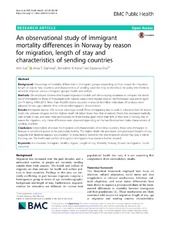| dc.contributor.author | Syse, Astri | en_US |
| dc.contributor.author | Dzamarija, Minja T. | en_US |
| dc.contributor.author | Kumar, Bernadette. N | en_US |
| dc.contributor.author | Diaz, Esperanza | en_US |
| dc.date.accessioned | 2019-05-20T14:21:38Z | |
| dc.date.available | 2019-05-20T14:21:38Z | |
| dc.date.issued | 2018-04-17 | |
| dc.Published | Syse A, Dzamarija, Kumar B, Diaz E. An observational study of immigrant mortality differences in Norway by reason for migration, length of stay and characteristics of sending countries. BMC Public Health. 2018;18:508 | eng |
| dc.identifier.issn | 1471-2458 | |
| dc.identifier.uri | https://hdl.handle.net/1956/19674 | |
| dc.description.abstract | Background: Knowledge of mortality differentials in immigrant groups depending on their reason for migration, length of stay in host countries and characteristics of sending countries may be beneficial for policy interventions aimed to improve various immigrant groups’ health and welfare. Methods: We employed discrete-time hazard regression models with time-varying covariates to compare the death risk of immigrants to those of Norwegian-born natives using linked register data on the Norwegian population aged 25–79 during 1990–2015. More than 492,000 deaths occurred in around 4.6 million individuals. All analyses were adjusted for sex, age, calendar time and sociodemographic characteristics. Results: Immigrants had an 11% survival advantage overall. Those immigrating due to work or education had the lowest death risk, whereas refugees had the highest death risk (albeit lower than that of natives). Death risks increased markedly with length of stay, and were most pronounced for those having spent more than 40% of their lives in Norway. Net of reason for migration, only minor differences were observed depending on Human Development Index characteristics of sending countries. Conclusion: Independent of reason for migration and characteristics of sending countries, those who immigrate to Norway in adulthood appear to be particularly healthy. The higher death risk associated with prolonged lengths of stay suggests that disadvantageous ‘acculturation’ or stress factors related to the post-migration period may play a role in the long run. The health and welfare of long-term immigrants thus warrants further research. | en_US |
| dc.language.iso | eng | eng |
| dc.publisher | BMC | eng |
| dc.relation.uri | https://bmcpublichealth.biomedcentral.com/track/pdf/10.1186/s12889-018-5435-4 | |
| dc.rights | Attribution CC BY | eng |
| dc.rights.uri | http://creativecommons.org/licenses/by/4.0/ | eng |
| dc.subject | Acculturation | eng |
| dc.subject | Immigrant | eng |
| dc.subject | Healthy migrant | eng |
| dc.subject | Length of stay | eng |
| dc.subject | Mortality | eng |
| dc.subject | Norway | eng |
| dc.subject | Reason for migration | eng |
| dc.subject | Social causation | eng |
| dc.title | An observational study of immigrant mortality differences in Norway by reason for migration, length of stay and characteristics of sending countries | en_US |
| dc.type | Peer reviewed | |
| dc.type | Journal article | |
| dc.date.updated | 2019-02-06T13:15:48Z | |
| dc.description.version | publishedVersion | en_US |
| dc.rights.holder | Copyright 2018 The Authors | |
| dc.identifier.doi | https://doi.org/10.1186/s12889-018-5435-4 | |
| dc.identifier.cristin | 1591941 | |
| dc.source.journal | BMC Public Health | |

